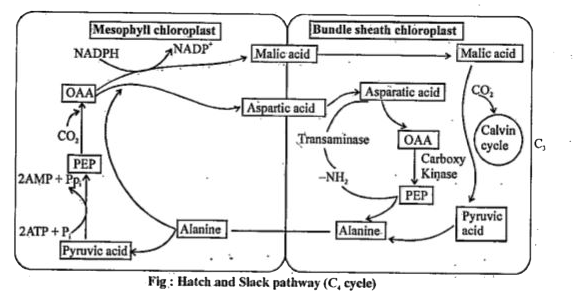Briefly describe the Hatch and Slack pathway of CO2 fixation in C4 plants.
Text Solution
Hatch Slack pathway or C4 pathway or dicarboxylic acid cycle: It was discovered by Hatch and Slack in (1965, 1967). It is found in those plants which occur in tropical and subtropical areas.
Examples: maize, sugarcane etc. These plants have another way of CO2 fixation in addition to calvin cycle. This is the alternative pathway of CO2 fixation. The first stable product is 4-carbon compound, Oxaloacetic acid. Therefore, this pathway is known as C4 cycle. The plants in which C4 cycle operate are called C4 plants. This cycle operates in mesophyll and bundle sheath cells. C4 cycle: This cycle is completed in the following steps:
i) Reaction in chloroplasts of mesophyll cells
a) In C4 cycle, initial fixation of CO2 occurs in mesophyll cells. The first acceptor of CO2 is phosphoenol pyruvate (PEP). It combines with CO2 in the presence of PEP carboxylase to form oxaloacetic acid.
PEP+CO2+H2OPEP Carboxylase−−−−−−−−−→ Oxalo-acetic acid+H3PO4.
b) Oxalo-acetic acid or converted to malic acid or transaminted to aspartic acid. These reactions take place in the presence of enzyme malic dehydrogenase or transminase respectively.
Oxaloacetic acid+NADPHDehydrogenase−−−−−−−−→Malic acid + NADP+
Oxalo-acetic acid + AlanineTransaminase−−−−−−−→Aspartic acid + Pyruvic acid.
ii) Reactions in chloroplasts of bundle sheath cells :
a) Malic acid or aspartic acid transported to bundle sheath cells through plasmodesmata. Inside bundle sheath cells CO2 freed from malic acid and aspartic acid.
Malic acid+ NADP+Malic enzyme−−−−−−−→CO2+Pyruvic acid + NADPH.
Aspartic acid + α-ketoglutaric acid Transaminase−−−−−−−→ glutamic acid + oxalo acetic acid.
Oxalo-acetic acid + ATP PEP Carboxylase−−−−−−−−−→PEP+CO+2+ADP
b) CO2 gas is released in bundle sheath cells. The chloroplast of bundle sheath cells contain enzyme of calvin cycle. So that CO2 is fixed to carbohydrates.

c) Above formed pyruvic acid is transported again to mesophyll cells. Here, it is again converted to PEP. The reaction takes place with the help of enzyme and expenditure of energy from ATP.
Significance :
i) C4 plants are better adapted to tropical cIimates.
(ii) C4 plants can absorb CO2 even from a much low CO2 concentration.
(iii) C4 plants can perform a high rate of photosynthesis even when the stomata are nearly closed.
iv) They maintain the high rate of photosynthesis under drastic conditions.
|
Updated on:21/07/2023
Knowledge Check
- Question 1 - Select One
In Hatch and Slack pathway
AChloroplast are of same typeBOccurs in Kranz anatomy where mesophyll have small chloroplast wheres bundle sheath have agranal chloroplastCOccurs in Kranz anatomy when mesophyll have small chloroplast where a bundle sheath have larger chloroplastDKranz anatomy where mesophyll cell are diffused - Question 1 - Select One
The first product of CO2 fixation in C4 -plants is
A3-phosphoglyceric acidBmalic acidCoxaloacetateDPhosphoenol pyruvate - Question 1 - Select One
Who proposed the CAM pathway of CO2 fixation
ABenson and associatesBRouhani and associatesCHatch and associatesDArnon and associates - Question 1 - Select One
In the Hatch and slack pathway, malic acid is formed in
AMesophyll cell maize leafBMesophyll cell of tomatoCMesophyll cell of bananaDMesophyll of cactus - Question 1 - Select One
The First carboon dioxide fixation products of C4 plants is
AOxaloacetateBPhosphoenol-pyruvateCMalic acidDPhosphoglyceric acid (PGA) - Question 1 - Select One
Enzyme that catalyses secondary CO2 fixation in C4 -pathway is
AaldolaseBPEP carboxylaseCisomeraseDRuBP carboxylase

